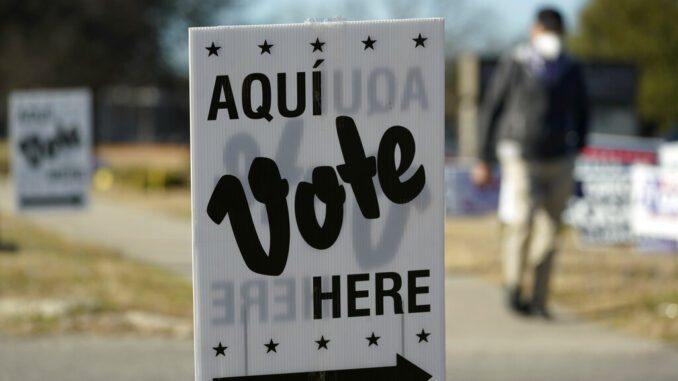
WASHINGTON, D.C. — Just 46 residents of Starr County, Texas, cast ballots in the state’s Republican primary two years ago. But last week, nearly 1,100 Republicans voted in the sparsely populated county that hugs the Mexican border.
A similar surge in Republican turnout unfolded across South Texas, a longtime Democratic stronghold dominated by Latino voters. In five U.S.-Mexico border counties, nearly 30,000 people voted in the GOP primary, an increase of more than 25% in participation from 2020.
The Texas primary, which ushered in the 2022 midterms, is emerging as an urgent warning for Democrats who are clinging to narrow majorities in Congress. The drift of Latino support toward Republicans that surfaced while former President Donald Trump was in office may prove to be a more enduring political trend that could force Democrats to reassess how they win elections.
The reverberations are being felt far beyond Texas. In South Florida, where Democrats were caught off guard by losing two House seats in 2020 that they’d flipped the previous cycle, some say the party must intensify on-the-ground operations that were largely suspended during the pandemic. Perhaps more fundamentally, they say, Democrats must do more to listen to the priorities of Latino voters and make fewer assumptions about their support.
“It plays to this elitist branding that the Democratic Party is trying so hard to shake,” said Devon Murphy-Anderson, the Florida Democratic Party’s former finance director. “You can’t do that when you’re pointing the finger at somebody and saying, ‘We know what’s best for you, and it’s our candidate.'”
Kellyanne Conway, a Trump adviser and his 2016 campaign manager, said she presented data on GOP inroads with Hispanic voters during last weekend’s Republican National Committee retreat.
“The left just sees them as immigration voters,” Conway said of Hispanic voters. By contrast, she said, Trump has helped Republicans win over Hispanics on issues including job creation, education and traditional religious beliefs: “We connected with them intellectually, economically and spiritually.”
Abel Prado, executive director of the Democratic advocacy group Cambio Texas in the Rio Grande Valley, acknowledged that Republicans have intensified candidate recruitment efforts that may have contributed to small gains in primary participation. But “when you look at the raw votes, we’re still outvoting them 3-to-1.”
Prado also said Republican efforts could backfire, ultimately energizing local Democrats.
“Hopefully the bad headlines do encourage candidates to invest way more heavily in the Rio Grande Valley,” he said. “Republicans are throwing money at the Valley without any remorse. You don’t see the same thing from Democrats.”
Mayra Flores, who won the Republican nomination for an open South Texas congressional seat last week, said former president Donald Trump “played a huge role” in energizing Latinos in part by labeling Democrats as socialists. Still, she said the party’s gains aren’t dependent on him being on the ballot — as last week’s turnout shows. She said she personally connected with voters.
“They’re finally seeing a Republican that looks like them, that has a similar story to them and shares their values,” Flores, who was born in Mexico and immigrated to the U.S. at age 6, said of voters in her district, which includes the border city of Brownsville. “I think that’s very important.”
Texas gained more residents than any state between 2010 and 2020, with Latinos driving the growth that swelled its population to 29.1 million. Trump won 35% of the Hispanic vote nationally in 2020, about the same as he won in Texas, according to AP VoteCast, a nationwide survey of the electorate.
But VoteCast showed he made inroads with Latino voters in some states, including Florida (45%) and Nevada (42%). Florida also saw its Hispanic and overall population boom according to last year’s census, and Trump won the state twice as Republicans ousted Democratic U.S. Reps. Donna Shalala and Debbie Mucarsel-Powell in Miami in 2020.
Last year, registered Florida Republicans outnumbered Democrats for the first time in modern history, and the GOP’s lead of active registered voters has widened in more recent months. Trump performed well with Cuban-American voters in South Florida and greatly narrowed Democrats’ lead in Miami-Dade County in 2020.
Dan Smith, a University of Florida political scientist who studies elections, said 2016 voters in heavily Cuban precincts had not heavily backed Trump, but that changed in 2020.
“Certainly Democrats have lost any advantage they once had,” Smith said, adding that GOP efforts to label Democratic candidates as socialist was effective among Cuban and Venezuelan exiles.



